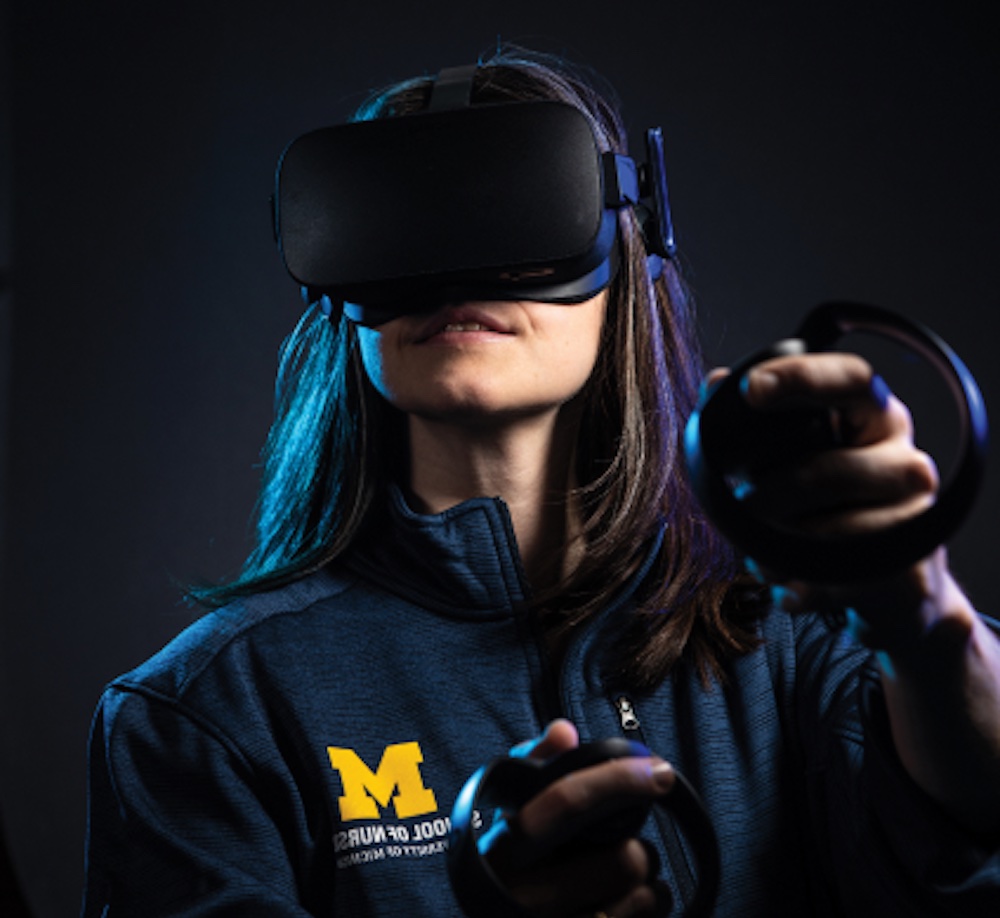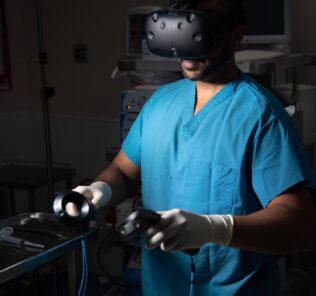360-Immersive Videos Support Veteran Care Providers
There is a new immersive healthcare simulation solution available that hopes to use extended reality (XR) to help providers better care for U.S. Veterans. The University of Michigan’s Nursing in XR series has placed a focus on how to best care for Veterans from all branches of the military. The goal is to create opportunities to honor those who have served the United States Military, and the university’s resources will work to help those who work with Veterans learn best practices in communicating and delivering care across a variety of healthcare settings. This HealthySimulation.com article explains why this emphasis on veteran healthcare support is so important and highlights topics covered by the UM XR series.
To cover such a range of topics, the University of Michigan team developed nine videos in this XR series that together outline elements of veteran care best practices and standards. To assist with learner understanding of these concepts, there are three videos that should be viewed first that set the foundations for certain basic concepts (Building Rapport with Military Veterans, Assessment Techniques in working with Military Veterans, and Establishing Relationships with Military Veterans).
The remaining videos can be viewed in any order depending on the user’s preference and primary learning objectives. Each video comes complete with an introduction, a video depicting a scene that shows interaction, and an invitation to reflect upon what the learner observed.
Sponsored Content:
According to the University of Michigan, the videos are not meant to be all-encompassing, but rather to create an opportunity to simply experience unique healthcare situations. This is meant to facilitate learner discussions and the exploration of best practices in providing such integral care.
“The use of immersive 360 video is a great way to provide an immersive learning experience where the learner feels like they are inside the action. The ability to highlight the healthcare challenges of our Veterans can lead to more holistic health care, whether they are receiving care in a civilian environment or in the VHA,” said Michelle Aebersold Ph.D., RN, CHSE, FAAN
a clinical professor at the University of Michigan School of Nursing.
Filmed in a 360-degree format, the immersive videos enable the viewer to look all around the environment and view the interactions from many angles. They can be viewed on a computer, tablet, or phone – or through a head-mounted display that supports virtual reality. For easy navigating, the videos are all linked on the University of Michigan’s YouTube website.
Additionally, many phones now have the option to select to view a video in VR using a product like Google Cardboard. Head-Mounted Display. For those viewing in a head-mounted display, the best way to access the videos is to first bookmark them on YouTube before accessing them in the head-mounted display. The user will then need to download YouTube VR on their headset for the best viewing, and then inside their headset select YouTube VR and navigate to the videos.
Sponsored Content:
360-Immersive Video Examples
VIDEO 1: Building Rapport with Military Veterans Description: This video introduces the learner to communication techniques that can be used to develop rapport and trust with military Veterans. Key concepts and debriefing points include:
1. Reflect on how you might feel if you were the patient in the scenario.
2. Consider how the interaction changed when the nurse became more engaged in the Veteran’s story.
3. Take time to learn about the concerns Veterans may have with their health care needs.
Recorded LEARN CE Webinar: Mixed Reality XR and Healthcare Education: What Does the Future Hold?
Presented by Laura Gonzalez, Ph.D., APRN, CNE, CHSE-A, ANEF, FAAN, this webinar explores the use of XR technologies in healthcare education both now, and in the future.
VIDEO 2: Assessment Techniques in working with Veterans Description: This video introduces the learner to conduct an assessment interview with military Veterans. The video also covers medical conditions such as tinnitus and depression. Key concepts and debriefing points include:
1. Reflect on the interaction and notice the differences.
2. When interacting with members of the Veteran community, take time to learn about their experiences.
VIDEO 3: Establishing Relationships with Military Veterans Description: This video introduces the learner to ways of communicating with Veterans, including showing interest in their military background and experiences. Key concepts and debriefing points include:
1. Reflect on how the nurse changed strategies once she recognized the patient as a Veteran. 2. Think about ways to apply this to future patient interactions.
VIDEO 4: Reintegration Challenges in Military Veterans and Families Description: This video introduces the learner to the challenges that are faced by military members when they return home from a deployment or when they transition out of the military into civilian life. Key concepts and debriefing points include:
1. Reflect on the challenges faced by family members of Veterans.
2. Explore resources you can use and share to support families and members of the Veteran community.
VIDEO 5: Musculoskeletal: Acute and Chronic Experienced by Veterans Description: This video portrays a situation in which the learner gains some understanding of the musculoskeletal conditions that may be experienced by military Veterans. Key concepts and debriefing points include:
1. Reflect on the way the nurse engages the Veteran and learns more about their situation.
2. Take time to learn more about the impact of certain military roles/jobs on the health and wellbeing of Veterans.
VIDEO 6: Caring for Veterans with Post Traumatic Stress Disorder Description: This video introduces the learner to some of the mental health conditions that may be experienced by military Veterans including Post Traumatic Stress Disorder (PTSD). Key concepts and debriefing points include:
1. Reflect upon how the nurse approached the topic of PTSD with the Veteran.
2. Learn more about how different experiences such as combat and deployments may impact Veterans.
VIDEO 7: Caring for Veterans with Environmental Exposures Description: This video introduces the learner to conditions that might be related to environmental exposures during deployments. Key concepts and debriefing points include:
1. Reflect upon how the nurse learned about the Veteran’s experience and potential exposures during deployment that can impact health.
2. Learn more about how environmental exposures can lead to illness in Veterans.
VIDEO 8: Caring for Veterans with Military Sexual Trauma Description: This video introduces the learner to some of the mental health conditions that may be experienced by military Veterans including sexual trauma. Key concepts and debriefing points include:
1. Reflect upon the way in which the nurse engaged with the Veteran around sensitive issues.
2. Observe how the interaction occurred in a manner that was respectful yet encouraging.
VIDEO 9: Caring for Veterans with Suicidal Thoughts Description: This video shows the learner an interaction that occurs when a military member is feeling suicidal and seeks help. Key concepts and debriefing points include:
1. Reflect upon the unique situations that are experienced by Veterans and how these impact their mental health.
2. Learn more about how different experiences such as combat and deployments may impact Veterans.
Another helpful resource, developed by XR Initiative Umich and published by the University of Michigan, Under the Skin, is a virtual reality 3D simulation to educate current and future healthcare providers on the dangers of vesicant chemotherapy drugs’ leakage and how to apply the best evidence in treating vesicant extravasation when it occurs.
Such immersive experiences are part of the University of Michigan’s dedication to employing continuous innovation. For example, The University of Michigan’s Center for Academic Innovation and Coursera announced they were partnering on 10 new courses enhanced by extended reality technologies in April 2022.
As part of the center’s upcoming Michigan Online Future of Work Academy, the new courses were meant to provide learners with the opportunity to develop skills critical to the future of work and society, and leverage XR technology to provide a level of immersion only possible in virtual, mixed and augmented reality environments. According to the university, the classes embrace technology that will help lead online learning for the next 10 years.
The Future of Work Academy is a flexible, noncredit curriculum online that will help people prepare for a new professional future. The XR-enhanced courses within the academy will feature immersive or interactive technologies, such as interactive 360 video, virtual media production, mobile phone augmented reality, and virtual reality simulations.
Read About Comparisons Between Military and Civilian Clinical Simulation
Lance Baily, BA, EMT-B, is the Founder & CEO of HealthySimulation.com, which he started while serving as the Director of the Nevada System of Higher Education’s Clinical Simulation Center of Las Vegas back in 2010. Lance is also the Founder and acting Advisor to the Board of SimGHOSTS.org, the world’s only non-profit organization dedicated to supporting professionals operating healthcare simulation technologies. His co-edited Book: “Comprehensive Healthcare Simulation: Operations, Technology, and Innovative Practice” is cited as a key source for professional certification in the industry. Lance’s background also includes serving as a Simulation Technology Specialist for the LA Community College District, EMS fire fighting, Hollywood movie production, rescue diving, and global travel. He and his wife Abigail Baily, PhD live in Las Vegas, Nevada with their two amazing daughters.
Sponsored Content:




















